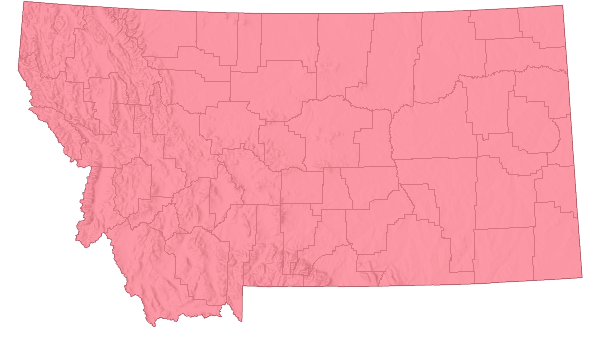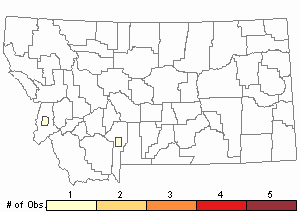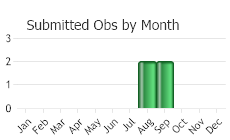View in other NatureServe Network Field Guides
NatureServe
Montana
Utah
Wyoming
Idaho
Wisconsin
British Columbia
South Carolina
Yukon
California
New York
Johnson Grass - Sorghum halepense
Other Names:
Johnsongrass
Non-native Species
Global Rank:
GNR
State Rank:
SNA
(see State Rank Reason below)
C-value:
1
Agency Status
USFWS:
USFS:
BLM:
External Links
State Rank Reason (see State Rank above)
Sorghum halepense is a plant native to the Mediterranean region and is introduced into North America (FNA 2003). A conservation status rank is not applicable (SNA) because the plant is an exotic (non-native) in Montana that is not a suitable target for conservation activities.
General Description
PLANTS: Warm-season perennial grass growing 1-1.5 meters tall from a stout rhizome. Stems are hairless except at their nodes where there are finely appressed hairs. Source: Lesica et al. 2012.
LEAVES: Leaf blades are flat and 10-15 mm wide. Leaf sheath margins overlap. Ligules are 1-5 mm long, membranous, and have a short fringe of hairs. Source: Lesica et al. 2012.
INFLORESCENCE: An open, diffuse, often purplish panicle of 15-35 mm long. The stem bearing the inflorescence (rachis) is short-hairy while stems bearing spikelets (pedicels) are long-hairy. Sources: Barkworth in FNA 2003; Lesica et al. 2012.
SPIKELET: Spikelets are borne in pairs with one being sessile and seed-bearing and the other bearing a stalk and stamens. Spikelets are dorsally compressed (such that glumes are not folded or keeled). Glumes have rounded backs and envelop the floret(s) almost completely. Glumes are purplish to greenish-yellow, hairless or nearly so, and have an acute tip. Lemmas are either unawned or with an awn of 8-13 mm long that is twisted, bent, and readily deciduous. Paleas are inconspicuous. Sources: Barkworth in FNA 2003; Lesica et al. 2012.
The common name of Johnson Grass originates from farmer Johnson who introduced it into Alabama from South Carolina in 1840 (Warwick and Black 1983). The genus Sorghum comes from Sorgho which is the Italian word for this plant (FNA 2003).
Diagnostic Characteristics
In Montana
Sorghum is differentiated by a combination of characteristics: dorsally flattened spikelets (layered like a sandwich); paired spikelets where one is sessile and the other stalked; leaf sheaths that lack an auricle; and relatively wide leaves with white mid-veins.
Johnson grass -
Sorghum halapense, exotic:
* Perennial grass that grows from stout rhizomes.
* Inflorescence is open and branched.
* Montana specimens were found in disturbed sites.
Shattercane -
Sorghum bicolor, exotic:
* Annual or short-lived perennial grass, lacking a rhizome.
* Inflorescence is wide and open or contracted (abruptly narrowed), but is always densely branched with spikelets.
* Montana specimens were found in cultivated fields.
Species Range
Montana Range
Range Descriptions

 Non-native
Non-native
Range Comments
Johnson Grass is native to the Mediterranean region of Africa and Europe (Howard 2004). Its range extends from Southern Ontario through the contiguous United States to northern Mexico. Johnson Grass was introduced as a forage species in the Southeastern United States, but has been cultivated to some extent for use as an ornamental. It is thought to have first been introduced in South Carolina around 1830. Since then Johnson Grass has widely escaped into warmer parts of the country but has not established persistent populations in the Pacific Northwest or Upper Great Plains (including Montana). New ecotypes have evolved allowing the species to expand its range (Howard 2004). In Montana it seems to rarely escape from cultivation.
In Montana the only documented specimen was collected in Gallatin County in 1917 (posted as of April 11, 2019 at https://www.pnwherbaria.org).
Observations in Montana Natural Heritage Program Database
Number of Observations: 4
(Click on the following maps and charts to see full sized version)
Map Help and Descriptions
Relative Density

Recency


 (Observations spanning multiple months or years are excluded from time charts)
(Observations spanning multiple months or years are excluded from time charts)
Habitat
Johnson Grass is found in disturbed areas (Howard 2004; Lesica et al. 2012). It will establish in wet and mesic sites, but has been limited in arid environments (Howard 2004).
Ecology
Johnson Grass has become a nuisance plant in many warmer states (mainly wet-temperate areas in the Southeast) (FNA 2003).
Johnson Grass is generally considered a good forage grass with relatively high palatability and nutrition (Howard 2004). However, plants produce toxic cyanogenic compounds at certain life cycle stages or under stress (Howard 2004). Young seedlings and sprouts have higher levels of cyanogenetic glycosides that can poison livestock and be harmful to the environment. Droughts and other environmental stressors can increase its glycoside levels (Howard 2004).
Reproductive Characteristics
Reproduction is by seed and rhizomes.
DISPERSAL
Spikelets disarticulate below the glumes when seeds are mature and dry (Lesica et al. 2012). The unit of dispersal is the spikelet.
HYBRIDIZATION
Johnson Grass can easily hybridize with Shattercane, and their progeny are wide-spread in the United States (Barkworth in FNA 2003).
Stewardship Responsibility
Threats or Limiting Factors
In warmer and wetter climates then exhibited in Montana, Sorghum halepense is considered a very harmful weed to the U.S. agricultural commodity (Howard 2004).
References
- Literature Cited AboveLegend:
 View Online Publication
View Online Publication Flora of North America Editorial Committee. 2003. Flora of North America North of Mexico. Vol. 25. Magnoliophyta: Commelinidae (in part): Poaceae, part 2. Oxford Univ. Press, New York. xxv + 781 pp.
Flora of North America Editorial Committee. 2003. Flora of North America North of Mexico. Vol. 25. Magnoliophyta: Commelinidae (in part): Poaceae, part 2. Oxford Univ. Press, New York. xxv + 781 pp. Howard, Janet L. 2004. Sorghum halepense. In: Fire Effects Information System, [Online]. U.S. Department of Agriculture, Forest Service, Rocky Mountain Research Station, Fire Sciences Laboratory (Producer).
Howard, Janet L. 2004. Sorghum halepense. In: Fire Effects Information System, [Online]. U.S. Department of Agriculture, Forest Service, Rocky Mountain Research Station, Fire Sciences Laboratory (Producer). Lesica, P., M.T. Lavin, and P.F. Stickney. 2012. Manual of Montana Vascular Plants. Fort Worth, TX: BRIT Press. viii + 771 p.
Lesica, P., M.T. Lavin, and P.F. Stickney. 2012. Manual of Montana Vascular Plants. Fort Worth, TX: BRIT Press. viii + 771 p.
- Additional ReferencesLegend:
 View Online Publication
View Online Publication
Do you know of a citation we're missing? Brey, C.W. 1998. Epidemiology of wheat curl mite (Aceria tosichella K.) and wheat streak mosaic virus on feral grass species and effect of glyphosate on wheat curl mite dispersal. Ph.D. Dissertation. Bozeman, MT: Montana State University. 136 p.
Brey, C.W. 1998. Epidemiology of wheat curl mite (Aceria tosichella K.) and wheat streak mosaic virus on feral grass species and effect of glyphosate on wheat curl mite dispersal. Ph.D. Dissertation. Bozeman, MT: Montana State University. 136 p. Bunkers, G.J. 1989. Biology of the eremophilanes produced by Drechslera gigantea. Ph.D. Dissertation. Bozeman, MT: Montana State University. 104 p.
Bunkers, G.J. 1989. Biology of the eremophilanes produced by Drechslera gigantea. Ph.D. Dissertation. Bozeman, MT: Montana State University. 104 p. Ito, D. 2011. Evaluation of susceptibility to wheat streak mosaic virus among small grains and alternative hosts in the great plains. M.Sc. Thesis. Bozeman, MT: Montana State University. 93 p.
Ito, D. 2011. Evaluation of susceptibility to wheat streak mosaic virus among small grains and alternative hosts in the great plains. M.Sc. Thesis. Bozeman, MT: Montana State University. 93 p. Lesica, P., M.T. Lavin, and P.F. Stickney. 2022. Manual of Montana Vascular Plants, Second Edition. Fort Worth, TX: BRIT Press. viii + 779 p.
Lesica, P., M.T. Lavin, and P.F. Stickney. 2022. Manual of Montana Vascular Plants, Second Edition. Fort Worth, TX: BRIT Press. viii + 779 p.
- Web Search Engines for Articles on "Johnson Grass"





